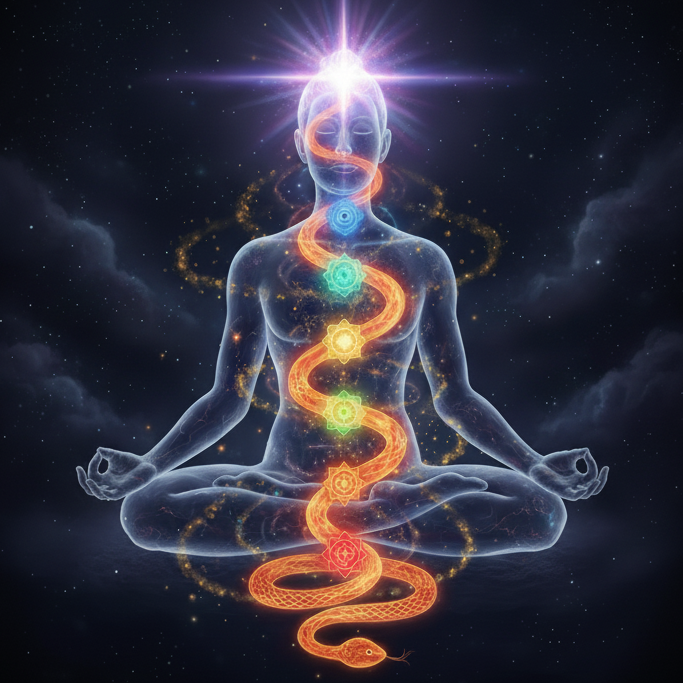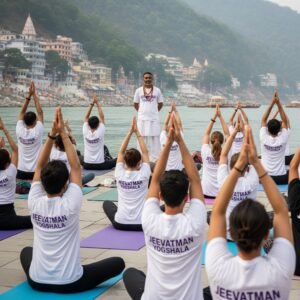Introduction
When most people think of yoga, images of meditation or graceful postures often come to mind. While these are certainly part of yoga, the true essence goes far deeper. At its core, yoga is about inner transformation — awakening the hidden potential within ourselves.
If you’d like a broader introduction,this Yogapedia article on Kundalini Awakening beautifully explains the concept and sparks curiosity for those starting their journey.
One of the most fascinating aspects of yoga is Kundalini awakening. Often spoken of with curiosity and even mystery, Kundalini represents the dormant spiritual energy that resides within every human being. Through yoga, this energy can be awakened, leading to profound physical, mental, and spiritual transformation.
In this article, we’ll explore what Kundalini awakening is, how it connects with yoga, its relationship with the chakras, the benefits, common misconceptions, and practical guidance for beginners.
What is Kundalini Awakening?
The term “Kundalini” comes from the Sanskrit word “kundal”, meaning “coil” or “spiral.” Yogic philosophy describes it as a coiled serpent resting at the base of the spine, in the Muladhara (Root Chakra). This serpent imagery symbolizes latent energy — quiet, still, and waiting to rise.
When this energy awakens, it ascends through the Sushumna Nadi, the central energy channel of the subtle body, activating the seven chakras along the way. Each chakra governs different aspects of life — from survival and creativity to love, wisdom, and ultimately, spiritual enlightenment.
When Kundalini awakening reaches the Sahasrara (Crown Chakra), it represents the union of individual consciousness with universal consciousness — the ultimate goal of yoga.

The Connection Between Kundalini Awakening and Yoga
Kundalini awakening is not separate from yoga — it is the flowering of yoga itself. Every practice in yoga, whether physical postures, breathing techniques, or meditation, is designed to prepare the body and mind for this awakening.
Here’s how key elements of yoga support Kundalini awakening:
Asanas (Yoga Postures)
Strong, flexible, and stable bodies are essential for handling the rising energy. Yoga postures remove blockages, strengthen the spine, and prepare the body as a vessel for Kundalini.
Pranayama (Breathwork)
Prana, the life force, travels through the body via energy channels (nadis). Breathing exercises like Kapalabhati, Anulom Vilom, and Bhastrika purify these channels, balancing prana and stimulating the dormant Kundalini energy.
Meditation and Dharana (Concentration)
A restless mind can block the flow of Kundalini. Meditation cultivates inner stillness, allowing energy to move upward naturally. Techniques such as mantra chanting, breath awareness, or focusing on the third eye are particularly effective.
Mantra and Sound Vibration
Each chakra has a unique bija mantra. Chanting these mantras creates vibrations that activate and open the chakras, allowing Kundalini to move freely. Sound is one of the most subtle yet powerful tools for awakening this energy.
Raja Yoga (The Royal Path)
Raja Yoga focuses on mastery of the mind. It prepares practitioners for the union of Shakti (energy) and Shiva (consciousness), which is the essence of Kundalini awakening.
Kundalini Awakening and the Chakras
As Kundalini energy rises, it activates the chakras, transforming life at multiple levels:
- Muladhara (Root Chakra): Grounding, stability, security
- Swadhisthana (Sacral Chakra): Creativity, emotions, sensuality
- Manipura (Solar Plexus): Willpower, confidence, personal power
- Anahata (Heart Chakra): Love, compassion, forgiveness
- Vishuddha (Throat Chakra): Communication, truth, expression
- Ajna (Third Eye Chakra): Intuition, clarity, wisdom
- Sahasrara (Crown Chakra): Bliss, spiritual union
The journey of Kundalini awakening is not just energetic but deeply transformative, helping us become grounded, loving, wise, and enlightened.
Benefits of Kundalini Awakening
Experiencing Kundalini awakening can be life-changing. Some of the most commonly reported benefits include:
- Deep inner peace and joy
- Healing of old emotional patterns and traumas
- Enhanced physical vitality and health
- Heightened creativity and intuition
- Improved clarity and focus
- A profound sense of connection with the universe
Common Misconceptions About Kundalini Awakening
Despite its benefits, Kundalini awakening is often misunderstood. Let’s address a few myths:
- “It happens overnight.”
In truth, awakening is usually a gradual process, unfolding step by step. - “It is dangerous.”
Kundalini itself is pure life energy. The danger only arises if one forces the process without preparation or discipline. - “It is only for advanced yogis.”
Kundalini exists in every human being. While advanced practices may require guidance, the preparation for awakening — like simple meditation, breathing, and asanas — is accessible to everyone.
Safe Practices to Prepare for Kundalini Awakening
Kundalini awakening is immensely powerful, like fire or electricity. That’s why ancient yogis always emphasized self-discipline, purity, and guidance from a teacher. When approached with respect and care, the awakening is not only safe but deeply blissful.
If you are just beginning, here are three simple daily practices that gently prepare your body and mind for the rising of Kundalini — without forcing the process:
- Morning Breath Awareness
Spend 5–10 minutes observing your breath. This calms the mind, balances energy, and lays the foundation for deeper practices. - Gentle Yoga Asanas
Practice spine-strengthening postures such as Cat-Cow, Cobra, and Bridge Pose. These open the central energy channel (Sushumna Nadi) and prepare the body as a vessel for Kundalini energy. - Mantra Meditation
Chant a simple mantra like “Om” while focusing on the third eye or heart center. Sound vibrations harmonize the chakras and create the right conditions for awakening.
Remember: The key is patience and consistency. These practices build a safe foundation for Kundalini awakening, ensuring the energy rises naturally, without discomfort.
Conclusion
Kundalini awakening is the hidden potential within every human being. Yoga is the science of awakening this energy. With consistent practice, patience, and guidance, Kundalini rises gradually, bringing transformation at all levels — physical, mental, emotional, and spiritual.
At Jeevatman Yogshala, we believe yoga is a sacred path of self-discovery. Kundalini is not something outside of you — it is already within, waiting to be awakened.
FAQ’s
Is Kundalini awakening dangerous?

Not at all. Kundalini is simply your inner energy. Problems only occur when people attempt advanced practices without preparation or guidance.
Can beginners practice Kundalini yoga?
Yes. Beginners can start with simple practices like meditation, breath awareness, and gentle yoga postures. Over time, one can gradually move into deeper practices.
How do I know if my Kundalini is awakening?
Some people feel tingling in the spine, bursts of creativity, heightened intuition, or sudden emotional release. But experiences differ from person to person.
Do I need a guru for Kundalini awakening?
A teacher is not always necessary, but guidance makes the journey smoother and safer. A guru can help interpret experiences and provide practices suited to your progress.
How is Kundalini yoga different from other forms of yoga?
Kundalini yoga specifically combines asanas, breathwork, meditation, and mantra to directly stimulate and awaken Kundalini energy. Other forms of yoga may focus more on physical or mental aspects.








